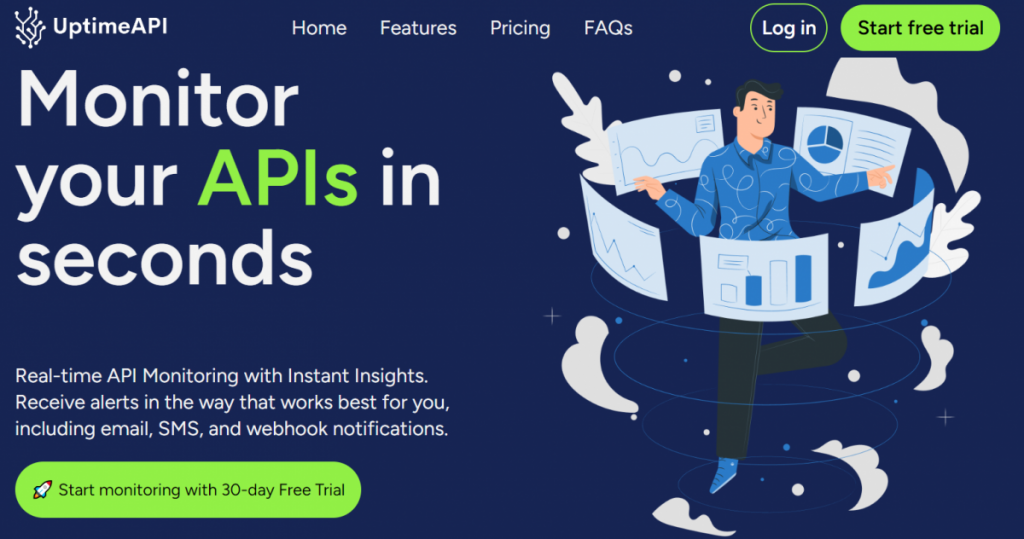Welcome, fellow developers, to a comprehensive tutorial on UptimeAPI, your go-to solution for monitoring the heartbeat of your digital assets. In this guide, we’ll walk through the process of integrating UptimeAPI into your projects effortlessly, ensuring you receive timely alerts and gain valuable insights into your application’s performance. So, buckle up, and let’s dive into the world of seamless monitoring API Alert.
Why UptimeAPI?

Before we get hands-on, let’s understand why UptimeAPI is a game-changer in the realm of API monitoring. UptimeAPI is designed with simplicity and effectiveness in mind, offering real-time monitoring, customizable alerts, and a user-friendly interface. Whether you’re a seasoned developer or just starting, UptimeAPI’s intuitive features make it accessible to all.
Getting Started – Step by Step Guide
1. Sign Up and Log In:
Begin by heading to the UptimeAPI website and signing up for an account. Once registered, log in to your dashboard to get started.
2. Dashboard Overview:
Familiarize yourself with the dashboard. UptimeAPI’s interface is designed for ease of use, providing a snapshot of your monitored assets and their current status.
3. Create a Monitoring Check:
To monitor your first asset, click on the “Create Check” button. Enter the URL or IP address of the asset you want to monitor. Configure settings such as the check interval, notification preferences, and response time threshold.
4. Generate API Key:
To integrate UptimeAPI into your application, you’ll need an API key. Navigate to the API settings section in your dashboard and generate a key. This key will authenticate your requests and ensure secure communication with UptimeAPI.
5. Make Your First API Request:
Let’s dive into the exciting part – making your first API request. Use your preferred programming language and make a simple GET request to the UptimeAPI endpoint. Don’t forget to include your API key in the headers for authentication.
GET https://api.uptimeapi.io/v1/checks
Headers:
Authorization: Bearer YOUR_API_KEY6. Analyzing the API Response:
Now, let’s break down what you can expect in a typical API response from UptimeAPI:
- HTTP Status Code:
- 200 OK: The request was successful.
- 401 Unauthorized: Invalid API key.
- 404 Not Found: The specified endpoint or resource does not exist.
Response Body:
- The body of the response will contain detailed information about the monitored asset, including its current status, response time, and other relevant metrics.
{
"id": "abc123",
"url": "https://yourwebsite.com",
"status": "up",
"response_time": 350,
"last_check": "2024-01-13T12:00:00Z"
}
Timestamps:- The last_check timestamp indicates when the monitoring data was last updated, providing insights into the asset’s recent performance.
7. Setting Up Alerts:
Customize your alert preferences to receive notifications when an issue is detected. UptimeAPI supports various notification channels, including email, SMS, and popular communication tools like Slack.
8. Advanced Features:
Explore UptimeAPI’s advanced features, such as custom checks, status pages, and global monitoring. Tailor the service to meet the unique needs of your application.
Why UptimeAPI’s API Response Matters

Understanding the API response is crucial for effective monitoring. The response provides real-time data that empowers you to make informed decisions. Here’s why the API response matters:
Instant Feedback:
- Receive immediate feedback on the status of your assets, allowing you to address issues promptly.
Performance Analysis:
- Analyze response times to identify potential bottlenecks or areas for optimization in your application.
Historical Insights:
- Leverage timestamps to track the historical performance of your assets, enabling trend analysis and proactive problem-solving.
Alert Triggers:
- The API response includes details about the asset’s status, triggering alerts when necessary. Stay ahead of potential problems with timely notifications.
Conclusion – Elevate Your Monitoring Game with UptimeAPI
Congratulations, developers! You’ve now mastered the art of integrating UptimeAPI into your projects. With real-time monitoring, customizable alerts, and a developer-friendly approach, UptimeAPI stands out as a reliable ally in ensuring your digital assets operate seamlessly API Alert.
As you embark on your journey with UptimeAPI, remember to explore its full range of features and customize them to suit your specific needs. The world of API monitoring just got more accessible – thanks to UptimeAPI, the beacon guiding developers toward uninterrupted digital excellence API Alert. Happy coding!
Read More: Company profile APIUsage Cases

